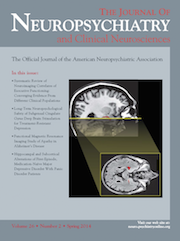To the Editor: Tardive dystonia is a rare and delayed side effect, reported with the use of antipsychotic drugs that occurs at a frequency of 1%−4%.
1 Tardive dystonia is usually associated with the use of typical antipsychotics. However, there are a few case reports describing it in patients treated with various atypical antipsychotics such as aripiprazole.
2 We report a patient with unspecified psychosis who developed cervical tardive dystonia on treatment with olanzapine.
Ms M., a 21-year-old unmarried woman, presented to psychiatry OPD at our hospital for the first time with complaints of neck stiffness and neck persistently turned backward for the last 5 months. There was no history of substance use, family history of psychiatric, movement, or neurologic disorder. She was a case of mild mental retardation and unspecified psychosis. Psychotic symptoms in the form of elementary auditory hallucinations, irritability, and anger outbursts had started at the age of 17 years.
She had been treated previously with trifluoperazine (10 mg/day) and aripiprazole (5–10 mg/day). With these drugs, either she had developed troublesome side effects or had not shown adequate clinical response. She had a history of developing extrapyramidal movements with various antipsychotics responding poorly to anticholinergics. About a year ago, she was started on olanzapine that was gradually increased to 15 mg/day. With olanzapine, her psychotic symptoms were in partial remission for the last 6 months. During the initial period of olanzapine use, she did not develop any side effects.
On physical examination, she had retrocollis; her neck was hyperextended with increased tone of posterior cervical muscles. Her brief psychiatric rating scale (BPRS)
3 score was 41 at the time of admission.
In consultation with a neurophysician, the patient was examined for Wilson’s disease and neuroacanthocytosis as possible causes for dystonia. Serum ceruloplasmin and urine copper were within normal limits. Peripheral blood smear did not reveal acanthocytes. MRI brain and EEG did not reveal any abnormality. As she was on olanzapine for a period of about 6 months before appearance of dystonic movements, she was diagnosed to have olanzapine-induced tardive dystonia, which was rated as severe on the ‘Trunk Movements’ subcategory of Abnormal Involuntary Movement Scale.
4 Olanzapine was cross tapered with quetiapine that was gradually increased to 300 mg/day. For dystonia, she was started on trihexyphenidyl 6 mg/day and tetrabenazine 25 mg/day. At the time of discharge, about a month after admission, her BPRS score was 22, and dystonia was rated as mild.
4Ms M had developed dystonia within 6 months of treatment with olanzapine. She was diagnosed to have tardive dystonia in accordance with criteria proposed by Burke et al.
1 These criteria include the presence of chronic dystonia, history of antipsychotic drug treatment preceding or concurrent with the onset of dystonia, the exclusion of known causes of secondary dystonia by appropriate clinical, and laboratory evaluation and negative family history of dystonia.
The treatment of tardive dystonia comprises of discontinuation of the causative antipsychotic drug and its replacement with other atypical antipsychotics.
5 In addition, dopamine depleting agent such as tetrabenazine, and anticholinergics such as trihexyphenidyl and clonazepam
1 are frequently used. However, the majority of the cases of tardive dystonia do not completely remit even after adequate treatment including withdrawal of the offending agent.
With inadequate evidence to substantiate the previous belief that association of tardive dystonia with atypical antipsychotics is weaker than the association with typical antipsychotics, constant monitoring and early detection particularly in patients with risk factors play a vital role in management.

